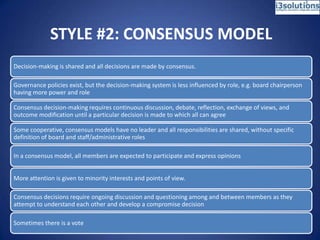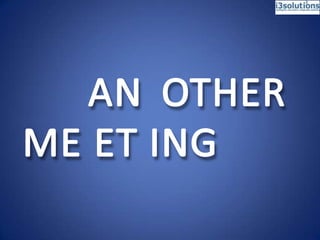SharePoint goverance - The Art of the
- 1. GovernanceThe Art of Growing the Possible45945 Center Oak Plaza, Suite 140Sterling, VA 20166703-652-8971LWilliams@i3solutions.com@sharepointlinc
- 2. 2Who is i3solutions?i3solutions is a Microsoft Managed Gold Certified IT Consulting Firm specializing in: We are celebrating our 12th year in business and have successfully implemented over 600 solutions for our clients.
- 3. Why is this Presentation Important?Most content focused on the technical aspects of GovernanceGood Governance is not so much about the technical act of enforcing rules, but more about the planning and nurturing you put into your portal
- 4. This presentation is…It’s not about the minutia of building policies and procedures for your environmentThat can be done in the basement of the science building … laterWe’re here to discuss what makes a good governance structure work!This is the Jack Bauer of Governance presentations, people Over the next 24 Minutes (ok maybe we will do 2 Seasons) we will look at the key issues. My weapon today…….PowerPoint
- 5. So Let it Begin!
- 6. Our Hero thought he could just relax and enjoy the SharePoint ConferenceWhile Jack was enjoying the free bagels….Unbeknownst to him his CIO was at the keynote
- 7. SharePoint – incredible demand, incredible capabilities …Bill Gates at the 2008 SharePoint Conference“There is an incredible demand today for solutions that help businesses to harness the power of a global work force and tackle the challenges that come with the explosive growth of digital information. The spectacular growth of SharePoint is the result of the great combination of collaboration and information management capabilities it delivers. I believe that the success we’ve seen so far is just the beginning for SharePoint.”
- 8. - Uncle Ben
- 9. Though Shalt Manage SharePoint!
- 10. Governance DefinedGovernance is the activity of governing. It relates to decisions that define expectations, grant power, or verify performance. It consists either of a separate process or of a specific part of management or leadership processes.ROOT: Psychology of Trust and FearAssuring, on behalf of those governed, a worthy pattern of good while avoiding an undesirable pattern of bad.
- 11. So What IS SharePoint Governance?11
- 12. Jack Got Ready to Swim this OceanWow!So Jack Climbed this Mountain….Not Knowing What Really Laid AheadThis is the Governance that people tackle today
- 13. This is the bulk of your Governance– the planning, reorganization, and transformation of your SharePoint environment
- 14. The Balancing ActInnovation&CreativityControlKeep it loose Establish some guidelines to keep users on trackbut keep the rules short and simple to avoid stifling creativity
- 15. KISS
- 16. Governance is….10% Philosophy25% Communication 20% Vision30% Social Engineering10% Control10% Trust 5% Technology
- 17. Technology is never the whole solution
- 18. Without effective governanceorganization, performance, andcapability are significantly reduced
- 19. SharePoint Without Governance is the Wild Wild West19
- 20. Why is Governance so hard?20
- 21. Let’s Talk About Perceptions
- 22. Governance!!!22Who think they look like this!Reality is thisWhich Causes….People envision this
- 23. Governance Should Be This23Alone we can do so littleTogether we can do so much~Helen KellerWorking Together
- 27. What is our Philosophy?Governance philosophy in today’s organizations focuses on productivity and resultsGreat Governance bodies define themselves as adding value and wisdom, helping with change and strategy decisions without micromanagingThey don’t hold back challenging questions but are also supportive of employees getting the job done
- 28. BELIEF STATEMENTSWe believe governing board members add value to our organization
- 29. We believe that our board must initially be involved in shared management, but
- 30. We are committed to a board that does not micromanage the portals day-today
- 31. operations
- 32. We believe our board functions best when all members engage in productive
- 33. dialogue
- 34. We believe that the priorities for the business must be our
- 35. We believe a 21st-century portal must focus on accountability
- 36. Our board should always know:
- 37. 1) where are we now in meeting our goals,
- 38. 2) where we need to be to meet our goals
- 39. 3) the best strategy to meet our goals
- 40. We believe that board, administrators, and users should have a shared understanding of goals, options, risks, and threats, and that all energy should be focused on our productivity and success
- 41. We believe our success, in part, depends on building a trusting and supportive organizational culture, which is focused on results.Style of Governance
- 42. STYLE #1: POLICY MODEL
- 43. STYLE #2: CONSENSUS MODEL
- 44. STYLE #3: MANAGEMENT TEAM MODEL
- 45. STYLE #4: ADVISORY MODEL
- 47. Governance is…. Vision
- 48. Vision - Do you have one?
- 49. If we do not communicate the Vision of the portal we are…
- 50. Visionüû...by providing a centralized location for people to find what they need...by having open communities and information/knowledge sharing through wikis, blogs, forums...by allowing for security controlled locations that can be used for versioning...by combining the disparate X number of home-grown intranet solutions...by...byMake it easier for people to work togetherEnable collaborationDocument managementPortalEliminate (reduce) emailIncrease ROI
- 51. What are the business outcomes?
- 54. PossibilitiesMany of SharePoint’s capabilities are not ‘required’ or ‘mandated’ users need to understand the value to get the benefitUsers can do a lot We can give them “great power” and need to ensure they accept their “great Responsibility”We have an obligation to guide and support them
- 55. Make SharePoint Work for the User43
- 56. Make SharePoint About the UserWho they areWho can help them Who everyone else isWhat they should and shouldn’t do How to get things done44
- 59. Policies47
- 60. Policies
- 63. CommunicationThink about communications as a “lifetime,” not “one-time,” process.Types of (strategic/targeted) CommunicationIntra-projectStakeholder(s)Community
- 64. Who Do Users go to??????????The Governing Body
- 65. Training Plan53
- 69. Governance is….Social Engineering
- 70. ANOTHERMEETING
- 71. EmpowerProvide business users a manageable solution to create, share and collaborate on Work
- 72. Inspire“Leaders establish the vision for the future and set the strategy for getting there; they cause change. They motivate and inspire others to go in the right direction and they, along with everyone else, sacrifice to get there.”Show them to use it in real world situationsShow them when not to use it
- 73. SupportHave answers for themTeach Them“Four things support the world: the learning of the wise, the justice of the great, the prayers of the good, and the valor of the brave”‘Tisnot enough to help the feeble up, but to support them after’~William Shakespeare Finely Tuned Performance & Expertise
- 76. It’s easy to make mistakes
- 77. Discussion65
Editor's Notes
- #12: PeopleRoles and responsibilitiesBusiness and technicalCreators and consumersTechnologyLet them know what the governance applies to. Ex: for the intranet, not the public facing site EX: web content only, not these standalone apps.PolicyLet them know what they can’t do.Where should certain activities take place?Where should they go to request change.ProcessCreate new spacesArchive informationAffect changePush info out to a user base.
- #20: What happens if we don’t have governance?
- #23: Because governance is RestrictionsI’m in charge and you’re notIn general, about as pleasant as being squashed by a housePeople don’t like being told what to do quite often ignore the need for governance
- #24: This is what SharePoint should bePeople working together towards a common goal.Whatever SharePoint isPlatformProductPortalIt should help get us further than if we don’t use it.
- #44: Now that we have defined who we are, where we are, and what we cannot do, we need to think about providing ways to work in this environment.
- #45: That’s why we have it, right?Define the roles people play with regard to the system.Important to remember that governance is heavily about definition, and capturing what should be happening.
- #53: Objective: Communicate that people need a clearer view of their customers.Talking Points:We’ve talked about how salespeople don’t have enough time to sell—and while that’s true, we also need to focus on knowing your customers too. Having more time to sell is great—but when all is said and done, it doesn’t mean much if you don’t know who to sell to. That’s why it’s important to identify your most valuable customer and prospects.Did you know that a full 40 percent—that’s almost half—of sales executives rate sales analytics as one of the top needs of their organization?* That means a lot of companies don’t have a good view of who their customers are. And when you consider that companies that retain 5 percent more customers typically increase profitability by 25 percent or more*, the case for knowing your customers is clear.40% of Sales executives rate Sales Analytics as one of the top needs for their organization (User Survey Analysis: Business Intelligence, Worldwide 2007: Gartner)56% of CSOs indicated they want to improve their ability to farm additional revenue from existing customers (Sales Performance Optimization -2007 Survey Results & Analysis – CSO Insights)The benefits of knowing your customers has a measureable impact on your bottom line: A recent study indicates differences in data quality can amount to a 66 percent shift in revenue from customers (Lager 2009).Ask yourself two questions:Have we identified the most important customer segments?Are we targeting, expanding, and retaining the right accounts?Can we following the information from Lead to Cash?[CLICK BUILD]Here’s what Microsoft offers to help you answer these questions.360 degree customer visibility by roleCustomer analyticsAnalytics for targeted sellingOPTION #1: Stay on this slide & review points below, then transition to Pillar 2 (Optimize Selling Cycles)360 degree customer visibility by roleSingle view of interactions across systems – see all your accounts, cases and interactions in one placeUser defined experience (web, phone, PC) - Contextual delivery based on sales roleCustomer Analytics for Strategic Segmentation Gain insight into customer purchasing behaviorIdentify and group customers more likely to buyCapitalize on new market opportunitiesAlign sales resources based on customer/prospect segmentationPredictive Analytics for Targeted SellingPinpoint high probability deals for closingProactively identify up/cross-sell opportunitiesMaximize revenue potential of current accountsTransition:Once you have identified the right customer and opportunities, do you have the processes in place to handle the leads?OPTION #2 – Proceed to next slide to discuss blue bar text in greater detail.Transition:Let’s go into each of these in detail:*User Survey Analysis: Business Intelligence, Worldwide 2007: GartnerThompson, Ed, and Nelson, Scott D., “How to develop a CRM Strategy,” (Gartner Research, December 27, 2004). *Reichheld, Frederick, “The Loyalty Effect,” (Harvard Business School Press, 2001).Additional Sales Role Points:Sales ExecutiveShift sales resources to impact growthSegmenting customers to drive growthIdentify and capitalize on market changes and trendsSenior Sales ManagerSeamlessly track all interactions, communications, purchases and inquiriesGain full visibility into customer information and purchase historySegment and target high-value customersProactively pinpoint and tailor up-sell/cross-sell opportunitiesSales OperationsDeploy systems that integrate data across multiple systems to provide full view of customer informationEnsure adoption of CRM tools that enable the collection of quality customer information.Improve cross-sell/up-sell rates via timely and relevant customer dataKeep your pulse on customer satisfaction with full visibility into interactions across all departmentsAutomatically track key renewal and contracts dates and take proactive measures while you can still effect change
- #59: You are not giving your presentation to have another meeting. You are there to convey meaning.

































































